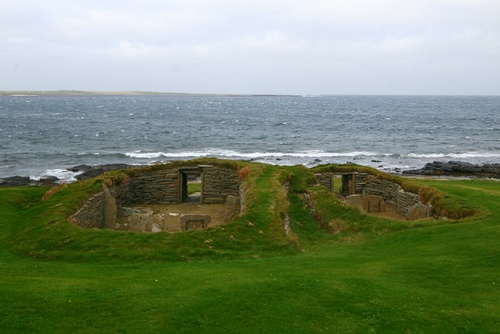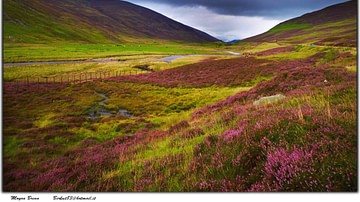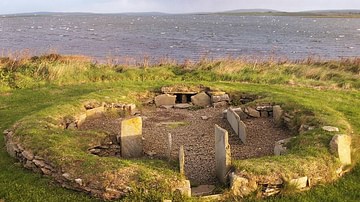
The Knap of Howar is a Neolithic site on the island of Papa Westray in Orkney, Scotland. The name is Old Norse for `mound of mounds' or `large barrow'. The building preserved at the site is considered the oldest stone house in northern Europe and is dated to 3700-3500 BCE. The site consists of two structures, commonly referred to as `the farmstead', built through dry stone construction with an adjoining passageway between them. Based upon archaeological excavations, it is thought that these structures were built on top of a much older site and formed the centre of a farming establishment.
The Old Norse name for the island of Papa Westray was Papay Meiri, meaning `Big Island of the Papars'. The Papars were legendary Irish or Scottish monks, referenced in Scandinavian works, who inhabited the northern islands of the Orkneys after leaving Iceland. As these sources for the Papars date from the 12th century CE, and the site is far older, it is possible these Papars were originally pagan priests who were later Christianized in legend. It is not possible, however, that Christian monks were the first builders and residents of the Knap of Howar (though there is much evidence on Papa Westray for later Christian activity) and it is almost certain that the inhabitants were a Neolithic Orcadian family of farmers. Archaeological evidence indicates the people there kept cattle and sheep and, perhaps, pigs, farmed the land to produce barley and wheat, and fished for food.
The stone walls of the farmstead stand to a height of five feet (1.6 metres) and, during the time of its occupation, would have been freestanding (today the building appears as though it was built into the earth). One of the buildings (House One) served as the living quarters for the family while the other (House Two), accessed through the adjoining passage, was a workshop and storage space of some kind. Both structures have doorways at the front facing the sea. The living quarters were relatively spacious at 35x18 feet (10x5 metres) and were separated by upright stone slabs which partitioned the front living area from a back kitchen or workroom. Evidence in the form of post holes suggests the roof would have been probably formed of turf raised some feet above the walls - though perhaps not too high in order to contain heat. The home was warmed by a fire in the hearth of the back (kitchen) area. The hearth is preserved intact as are the stone beds and shelves of the home. It is thought the beds would have been covered with heath to form mattresses.
House Two, the smaller of the buildings, measures 25x12 feet (7x3 metres) with thinner walls which stand to the same height as the main house. This building is partitioned into three areas; two seem to have been for storage and a third used as a workroom. Pottery shards and stone and flint tools were found on the floor throughout. There were two hearths and grinding stones also found in situ. The passage way connecting the two buildings was, at some point, blocked by stone, seemingly on purpose, and the workshop abandoned. The main house continued to be occupied long after the passageway was closed and archeologist Anna Ritchie concluded the site was in constant use for over 900 years. Today the Knap of Howar sits fairly close to the coast but, in its days of occupation, it would have been inland from the sea in what was probably a wide meadow. Archaeologists and geologists have both confirmed this theory based upon evidence at the site and geological studies of erosion patterns on the island.
The site was first excavated in the summer of 1929 CE when the owner of the land, William Traill, found the sturdy stone walls in the earth which had been partially uncovered by strong gales the preceding winter. With the aid of a friend, William Kirkness, he uncovered the two buildings and removed debris and artifacts. The two men dated the buildings to the Iron Age but excavations in the 1970's by Anna Ritchie placed the structures in the early Neolithic Age and, further, showed that the buildings were continually inhabited for over 900 years. Although much of the material of interest had been removed from the two buildings, Ritchie found evidence of Unstan ware pottery shards, indicating that the inhabitants had been in contact with and traded with people of central Orkney and possibly even further south. According to `Adventures in Archaeology', “Since Unstan ware was found in the earliest type of tomb in the Orkneys, you would expect to find a similar one nearby for the people of Knap of Howar” yet nothing, so far, has been detected. It is possible that the tombs which existed long ago fell into the sea through the erosion of the land or that they simply remain concealed. Recent excavations at the site of the Ness of Brodgar, on the main island of Orkney, have shown conclusively that entire settlements, of great significance, can still lie buried in plain sight waiting to be revealed.





